Easy to grow summer berries
Luscious raspberries, blackberries, boysenberries and blueberries are for many a luxury purchased at the supermarket, but growing berries in your own garden is easier than you think. No matter what size your property, there is a berry option for you to grow your own.
Berry fruits require plenty of sun, shelter from strong winds and free-draining, compost- enriched soil. All berry fruits can be grown in large pots in the best position if the soil or site of your garden does not suit.
BLUEBERRIES
Blueberries are an easy-care fruit and can provide masses of health-giving tasty fruit. They are wonderful decorative shrubs with spring flowers, summer berries and colourful autumn foliage, and make an ideal edible hedge.
There are many varieties of blueberry to choose from to suit your climate, and it is possible to choose 5-6 varieties and harvest blueberries from late November through to early April.
Blueberries are cold hardy and require chilling to set fruit. The two main types of blueberries grown in New Zealand are Highbush and Rabbiteye.
- Highbush blueberries are self-fertile but will pollinate better with more than one variety. There are two groups:
- Southern highbush which flower earlier and are almost evergreen, so are suited to warmer areas with low winter chilling. Best for regions from Waikato and north.
- Northern highbush flower late in spring and are deciduous so suit cool areas, with high winter chilling. In southern regions, these varieties are the best choice.
- Rabbiteye are mostly self-sterile, so growing two or more varieties is important. They flower mid-spring and are tolerant of extremes of temperature and soil moisture, so can be grown in all but the coldest regions.
Blueberries are available most of the year and can be planted anytime. They prefer a slightly acidic soil so when planting, enrich with plenty of organic matter (compost), and avoid using lime. Use controlled release fertiliser as a base food when planting. If planting for a hedge, space the plants 0.6-1m apart, or 2m apart to grow as a bush.
Blueberries have a shallow root system, so water to keep moist through the growing season; mulching will help retain moisture. They will need protection from frost when flowering. During flowering and fruiting, apply acid plant food (for acid loving plants eg rhododendrons, azaleas) every six weeks.
Blueberries will be ready for picking from December through to April depending on the variety and your location. Don't rush to pick the berries as soon as they turn blue. Wait a couple of days and when they're ready, they should fall off into your hand.
Blueberries fruit on wood grown the previous season. To sustain good fruiting, prune the growth that carried the crop as soon as it is picked in summer. This encourages new growth to maintain a compact bush.
BRAMBLES
Blackberries, Boysenberries, Loganberries, Marionberries and Raspberries fall into this category of ‘rambling berries’. These modern varieties of brambles are better behaved than their unruly cousin that grows wild on roadsides and waste ground. Some varieties are even thornless!
Good drainage and a soil enriched with compost is a good way to start your plants. Use a controlled release fertiliser as a base food when planting. In spring, feed with a berry or rose fertiliser and mulch around plants to keep their roots slightly moist. Keep the plants well-watered during dry spells.
Raspberries grow on upright ‘canes’. They are categorised into ‘summer-fruiting’ and ‘autumn-fruiting’ types.
Summer fruiting raspberries fruit on previous year’s growth and will require support against a trellis or fence for the tall canes. Autumn-fruiting raspberries are shorter and usually less vigorous, and fruit on the current season's growth. Grow a selection of the two types so you can harvest your own delicious raspberries from late December through to April.
Raspberries prefer a cool climate but if you can grow apples in your garden, then raspberries will follow suit. Choose a sunny spot sheltered from harsh winds and that will provide escape from the hot afternoon summer sun if you live in the north.
Ripe raspberries will be full of colour and slide easily off the core into your hand. After fruiting, cut all canes that have carried fruit down to soil level, leaving new canes to develop for the following year.
Blackberries, Loganberries, Boysenberries, Marionberries are vigorous growers and need support for their long canes against a trellis or fence. Plant at 2 to 3m apart. Fruiting time is generically December to January.
The Loganberry is a cross between a raspberry and a blackberry with long conical maroon-red fruit with a tart slightly sweet flavour. The plant is more sprawling and cold hardy.
The Boysenberry is a complex hybrid of raspberry, loganberry and blackberry. Most varieties for home gardens are thornless. The ripe fruit are reddish-black and sweeter and juicier than a loganberry. The plant grows more upright and is less cold tolerant.
The Marionberry is another complex hybrid of raspberry, loganberry and blackberry, looking like an overgrown blackberry. The fruit are prolific, plump, and juicy with intense flavour and high levels of nutrients.
Unlike raspberries, the ripe fruit of these berries come away from the plant with the core inside. Unripe berries will not pull away from the plant easily and will not ripen off the plant.
The canes of these berries only fruit one season and should be pruned away after harvest to make room for new fruiting canes. Tie the new canes to the supporting trellis or fence.
BLACK CURRANTS
A little grown fruit with an old-fashioned image, the black currant has twice the levels of antioxidants of blueberries and five time the vitamin C of oranges. They can be grown in all but the warmest regions and do well in cold climates.
Plant black currant bushes in a sunny spot with moist well-drained soil. Use a controlled release fertiliser as a base food when planting and feed with a berry or rose fertiliser in spring and summer. They are ideal to grow as a hedge which makes protecting them from birds with mesh a little easier.
The currants are produced on two- and three-year-old wood so anything older should be pruned out every winter.
GOOSEBERRIES
Gooseberries hold a nostalgia for days past, growing in the gardens of our (great) grandparents. Arriving in NZ from Britain, they were an easily grown source of fresh fruit, albeit on the sour side, and used to create pies, fools, tarts and jellies - until they fell out of favour with the arrival of mildew which reduced the variety of gooseberries down to two or three resistant types. Plentiful thorns make picking the fruit and pruning the bush challenging.
Gooseberries are one of the first summer berries to ripen and they take up little space in the garden. Gooseberry fruit are a slightly bristly, and usually green but there are also red variants. Their flavour can be anything from tart and tangy to sweet and mellow. A mature bush can yield up to 4kg of fruit. Thin out a heavy crop when the berries are small to get good sized fruit.
Gooseberries prefer to grow in cooler regions for winter chilling to set fruit, however there are varieties suited to areas with warmer winters. Plant gooseberries in an open sunny position in free draining but moisture retentive soil. Use a controlled release fertiliser as a base food when planting and feed with a berry or rose fertiliser in spring and summer.
Prune in winter, to create an open bush that allows good air flow. Develop a framework of a short main stem from the ground with radiating side stems forming a permanent goblet shape. Shorten these by half every year, thinning excess side growth and remove all other shoots from the base.
PROTECT YOUR CROPS
The few pests and diseases that can attack berry fruit tend to be minor or easily controlled. Brambles will get botrytis (grey mould) if there is wet weather during picking and may suffer from dry berry disease, caterpillars, and mites. Gooseberries are attacked by powdery mildew although today’s varieties are somewhat resistant. Currants can be attacked by a stem borer.
Protect ripening fruit from birds. Don’t waste your effort growing fruit if the birds are the only ones to eat it. Start to net fruit as it begins to colour. Use bird netting either draped directly over the bush or build a frame to fit bird netting over. Pin down the edges because the birds will take advantage of any gaps.

15-Sep-2023
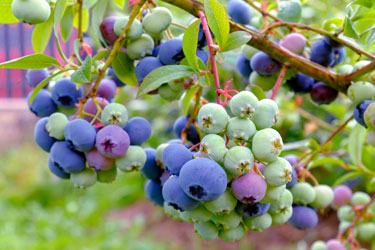
Blueberries
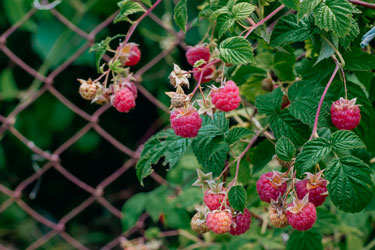
Raspberries
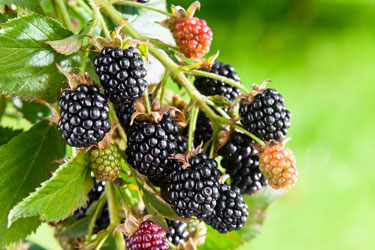
Blackberries
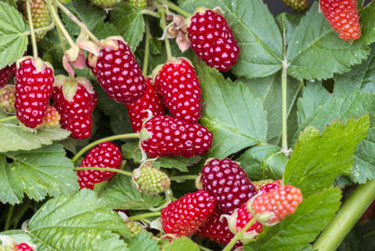
Loganberries
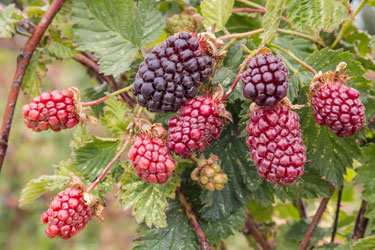
Boysenberries
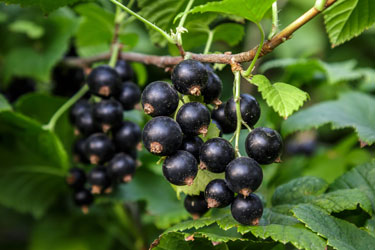
Black currants
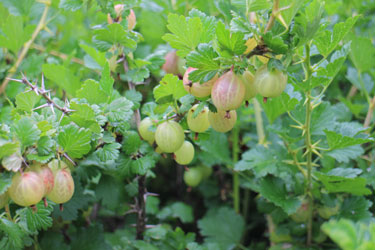
Gooseberries
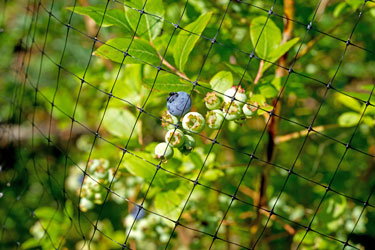
Bird netting

